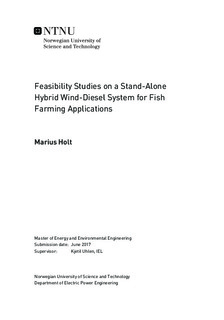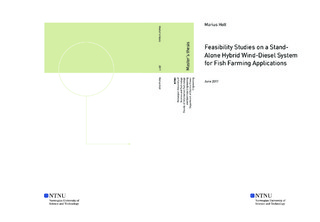| dc.description.abstract | This thesis aims to explore feasibility related to implementing a Hybrid Wind-Diesel System for an offshore fish farm. The primary motivation behind this is to exploit the excellent wind resources along the Norwegian coast in order to reduce CO\textsubscript{2} emissions related to the operation of diesel generators (DGs). Thus, instead of diesel as the only source of electrical power, the hybrid system will utilise a wind turbine and battery system to reduce the diesel generator's operating time as much as possible. Additionally, excessive wind energy from the wind turbine could be used to run auxiliary equipment on the farm, such as oxygen production, washers for lice removal and freshwater production.
As a starting point, the thesis provides a clear and perspicuous overview of both conventional offshore fish farms and Hybrid Wind-Diesel Systems in general. This constitutes the basis for building a suitable model from fundamental blocks in the MATLAB\textsuperscript{\textregistered}/Simulink environment. The purpose is assessing the system's dynamic performance when exposed to disturbances. Figure \ref{fig:ab_syst} displays the system layout schematic.
The hybrid system comprises a Permanent Magnet Synchronous Generator (PMSG) wind turbine, connected to a 400 V AC bus bar through a back-to-back Voltage Source Converter (VSC) and a step-down transformer. The purpose of the turbine VSC is to facilitate variable speed operation of the turbine and also enhance system control. The battery is of Lithium-ion type and incorporates a VSC for AC/DC conversion. The fish farm also contains an Electrically Excited Synchronous generator (EESG) associated with a diesel engine. This can be used for fast active and reactive power support if the wind and battery system fails to cover the load. The main load is a fixed, inductive load together with a variable-speed Induction Motor (IM), and the dump load consists of a variable inductive load and a directly connected IM. Three critical situations have been investigated. These represent some of the most frequent and severe situations that the system will have to endure on a day-to-day basis. Start-up of the directly connected IM proved to be the most critical scenario, due to the high initial reactive power requirement. If sufficient resources of reactive power are not present, this may lead to a permanent voltage collapse. Starting the DG during sudden shortfall of wind indicated redundancy. However, the importance of bringing it online in generator operation and not in motor operation was highlighted. Start and stop of the feed blowers induced little stress on the system, even at low wind speeds. Overall, the system shows promising performance during most of the investigated disturbances. | |

